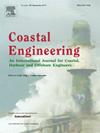Growth of wind-driven waves under uniform currents
IF 4.2
2区 工程技术
Q1 ENGINEERING, CIVIL
引用次数: 0
Abstract
This study experimentally investigated the growth of wind-driven waves under uniform currents. The wind-driven wave spatiotemporal evolution characteristics were collected along the fetch, and visual techniques were used to measure the phase velocity and flow field characteristics. Based on the experimental results, the variation patterns of dimensionless peak frequency and energy over time and space were analyzed, and their relationships with the dimensionless current velocity, fetch, and wave age were determined. The currents significantly influence the trend in dimensionless energy, with their effect on peak frequency and dimensionless energy primarily reflected in the exponential term. The exponent coefficient of peak frequency for the co-current is approximately , while for the counter-current, it is , where is the current velocity, is the wind friction velocity, and is the dimensionless fetch. Both co- and counter-currents increase the turbulent kinetic energy. The co-current minimally affects the velocity field distribution, with the Q4 quadrant dominating in the quadrant analysis. In contrast, the counter-current significantly alters the velocity field, shifting the Reynolds stress dominance from Q4 to Q2 and resulting in a more evenly distributed four-quadrant pattern, enhancing the upward momentum transfer. These changes in momentum transfer significantly affect the spatiotemporal evolution of wind-driven waves under uniform currents.
风浪在均匀的水流下生长
实验研究了均匀海流条件下风浪的生长。采集风浪沿风浪方向的时空演化特征,利用视觉技术测量相速度和流场特征。基于实验结果,分析了无量纲峰值频率和能量随时间和空间的变化规律,并确定了它们与无量纲流速、流速和波龄的关系。电流显著影响无量纲能量的变化趋势,其对峰值频率和无量纲能量的影响主要体现在指数项上。共电流的峰值频率指数系数近似为Uc/u∗,而逆流的峰值频率指数系数为6χ∗−0.26Uc/u∗,其中Uc为电流速度,u∗为风摩擦速度,χ∗为无因次流。共流和逆流都增加了湍流动能。共电流对速度场分布的影响最小,在象限分析中以Q4象限为主。相反,逆流显著改变了速度场,将雷诺应力优势从Q4转移到Q2,导致四象限分布更均匀,增强了向上的动量传递。这些动量传递的变化显著地影响了均匀海流条件下风浪的时空演化。
本文章由计算机程序翻译,如有差异,请以英文原文为准。
求助全文
约1分钟内获得全文
求助全文
来源期刊

Coastal Engineering
工程技术-工程:大洋
CiteScore
9.20
自引率
13.60%
发文量
0
审稿时长
3.5 months
期刊介绍:
Coastal Engineering is an international medium for coastal engineers and scientists. Combining practical applications with modern technological and scientific approaches, such as mathematical and numerical modelling, laboratory and field observations and experiments, it publishes fundamental studies as well as case studies on the following aspects of coastal, harbour and offshore engineering: waves, currents and sediment transport; coastal, estuarine and offshore morphology; technical and functional design of coastal and harbour structures; morphological and environmental impact of coastal, harbour and offshore structures.
 求助内容:
求助内容: 应助结果提醒方式:
应助结果提醒方式:


